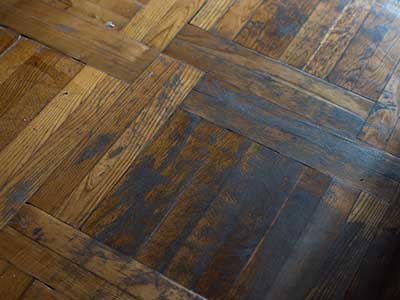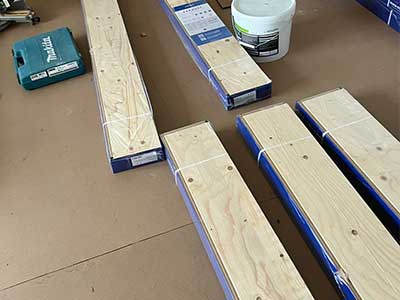Back to Flooring Products
Effects of Moisture on Real Wood Flooring
 Real wood flooring, as the name suggests, is an entirely natural product. Even when cut into floorboards, wood remains to have its natural response to changes in its environment. Among the major aspects that can provoke this natural response from wood are temperature and humidity fluctuations, and changes in the indoor moisture content.
Real wood flooring, as the name suggests, is an entirely natural product. Even when cut into floorboards, wood remains to have its natural response to changes in its environment. Among the major aspects that can provoke this natural response from wood are temperature and humidity fluctuations, and changes in the indoor moisture content.
Since wood has naturally a porous structure, the density depends on the sort of wood species in question, however, all wood species have a porous structure to some extent, this wood’s specific means that moisture and humidity definitely have an impact on a wooden floor and cause some changes. Not necessarily, however, these changes can sometimes lead to some issues and you definitely don’t want to deal with such situations. Therefore, today we provide you with more in-depth information on the effects of moisture on real wood flooring.
Wood Flooring and Natural “Movement”
It does not matter that a tree is cut down into little flooring boards and blocks, its natural response to changes in its environment remains even when the wooden floor is installed, sanded, finished, and used for years. Because of the wood’s porous structure, moisture can have a serious impact on the wooden floorboards. This does not necessarily mean you will experience serious issues with your wooden floor, therefore you better not invest in one in the first place. Not at all, nothing should stop you from enjoying a beautiful, elegant, and durable real wood floor. However, when owning a wooden floor, there are some situations you definitely want to prevent and avoid in order to keep your floor in its top shape for many decades.
Now, changes in the floor’s environment, mostly when it comes to changes in the indoor moisture content, temperature and humidity fluctuations, affect the floorboards by making them expand and contract. This is the simple response of wood to what is happening in the indoor space where it is installed. If the moisture content in the indoor air is higher than what the floor is acclimatised to, the floorboards will start absorbing a certain amount of the moisture and they will start swelling and expanding.
Once the indoor air gets less humid, the floorboards will start shrinking and contracting, losing the absorbed moisture and getting dryer. This “movement” of the floorboards is an entirely natural process and, most commonly, there is nothing to worry about. In general, the wood will have good control of this movement, expanding and shrinking without causing some serious damage to the structural stability of the floor. However, in case the temperature and humidity fluctuations are beyond what is considered normal for the floor’s indoor environment, there is the possibility for the floorboards to get damaged and experience a number of issues that require floor repair and, unfortunately, in rare cases even replacing the floor.
Real Wood Flooring in Winter and Summer
Wintertime and summertime are the two main periods of the year that can potentially affect the condition and structure of your wooden floor. For example, during the colder months when heating is used inside the house, the wooden floorboards will usually get drier and with lower inherent moisture content which can lead to the floorboards contracting and shrinking. Therefore, it is not a rare occasion that gaps between the floorboards start occurring during wintertime. As a result, the insulation of the floor is weakened and draughts of cold air from outside could enter the room and lower the efficiency of your heating system. This can also work the other way around in the summertime.
Once the temperatures go up and the heating is off, the humidity level of indoor air is increased. As a result, the hardwood floor may start absorbing moisture again and this will make the floorboards expand again. Now, in the common situation, this would not be a problem at all and the floor won’t be the subject of issues that require a repair or are beyond repair. However, in extreme cases of significant temperature fluctuations, there is a risk of a number of issues including cupping, warping, and ballooning of the floorboards which can lead to them breaking, getting loose, the nail heads popping up, weakened wood floor adhesive, chipped or destroyed finish, etc. In this case, make sure to contact a professional and have your floor thoroughly inspected and the problem evaluated and assessed. Only an experienced and knowledgeable professional would be able to recommend what should be done in order to bring back your floor to its initial condition and stability.
The Importance of Acclimatisation
 The acclimatisation of the floorboards is one of the most important initial steps that should be done before the installation of the floor. While leaving the factory and getting transported to your home or to the site, where installation is taking place, the floorboards will most certainly experience different changes in their environment which can be stressful and affect them by making them expand and contract to an extent.
The acclimatisation of the floorboards is one of the most important initial steps that should be done before the installation of the floor. While leaving the factory and getting transported to your home or to the site, where installation is taking place, the floorboards will most certainly experience different changes in their environment which can be stressful and affect them by making them expand and contract to an extent.
You definitely want to make sure that the floorboards are acclimatised and getting used to the specific conditions and environment of your home so the installation is as smooth and successful as possible. Therefore, once you have the flooring materials and boards delivered to your home, make sure to have them out of the transportation packaging and leave them in the room or space where the installation will happen. Allow at least a few days for the floorboards to get used to their new environment.